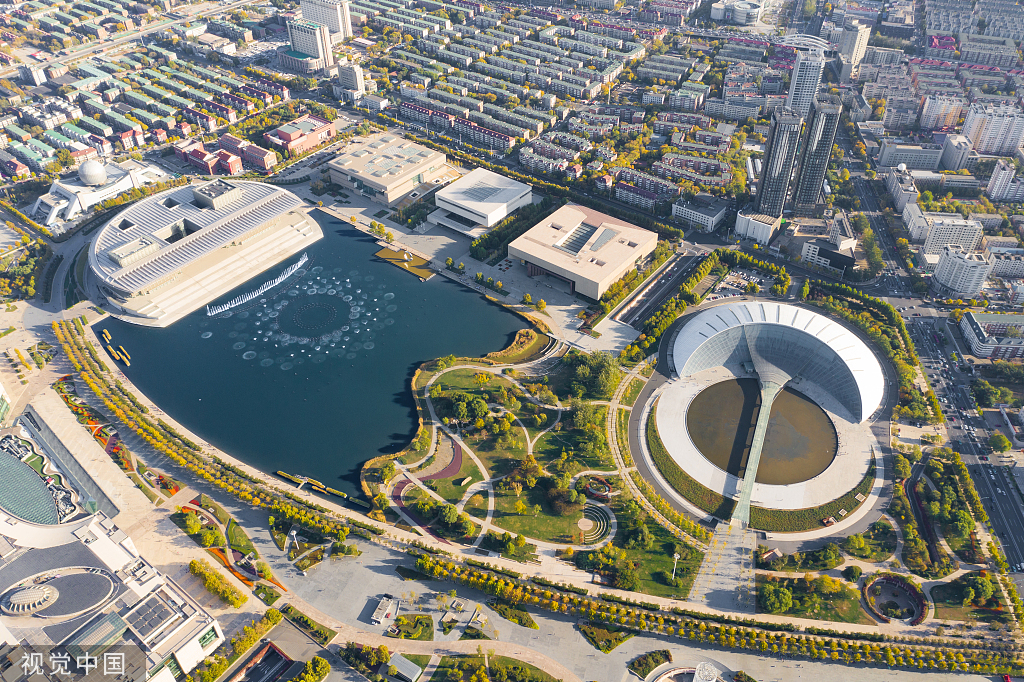Tianjin municipal legislature approves new regulation to protect city skyline

An aerial view helps illustrate the scope of the Tianjin Cultural Center in Tianjin, Oct 27, 2018. [Photo/VCG]
The country's first provincial-level regulation to strengthen the management of a city's skyline took effect in late July in the municipality of Tianjin, said its legislature.
The city's people's congress announced it had reviewed and approved the decision to control the skyline in key areas on July 27, which then officially came into effect.
Yan Dingzhong, director of the Urban Construction and Environmental Protection Committee of Tianjin People's Congress, said the regulation will improve urban lifestyles and the quality of the city, and promote high-quality development.
He said the regulation is aimed at boosting scenic views, unique architectural styles, harmony among the landmark buildings as well as the natural scenery.
Areas involved include urban core areas, emerging towns and new areas, historical and cultural blocks, city parks and other public open spaces.
Architectural design should focus on the control of building height, width, volume and shape, and strengthen the coordinated design of building facades and building roofs.
The decision stipulates that Tianjin should create a unique coastal skyline, and optimize urban patterns and spatial forms.
The regulation prevents a building from being demolished, modified or constructed without authorization, or to change the original facade, color and shape, if it would destroy the skyline.
Outdoor advertising and commercial plaques should also be integrated with the architectural style.
Chen Yong, Party chief of the Tianjin Planning and Natural Resources Bureau, said, "In the past, our planning mainly focused on the plan layout, but this time we turn to a three-dimensional perspective."
The city has taken measures to limit the height of the cornices of the buildings in the Wudadao area, also known as the Five Greater Avenues area, which boasts an array of Western villas; and has created a harmonious design among the heights of buildings along the banks of the Haihe River.
"We hope to forge our unique style of Tianjin's urban skyline in the future, thus we incorporate the piedmont area of Jizhou and the coastal area of Binhai to planning and control," he said.
Lyu Wei, a designer with the Tianjin Urban Planning and Design Institute, said, "We expect residents and visitors to appreciate the city from different angles with the flowing skylines and the harmonious beauty from the heights, structure and style of different buildings.
"For example, the skyline in the area where Tianjin Tower, one of the highest towers in Asia, the Drum Tower with a history of 618 years as well as its surrounding architecture are located, are cases in point."
The National Development and Reform Commission announced the latest regulation to limit the height of buildings on July 12.
It said the country no longer allows the construction of buildings above 500 meters and limits the number of newly approved buildings that are above 250 meters.
Local governments should carry out in-depth research and make layout plans for buildings above 100 meters.
Some foreign countries also have regulations about their city's skylines. In London, for example, new buildings surrounding historical buildings are not allowed to block views. Key buildings in the Square Mile in London, a cluster of leading financial companies, are required to create skylines to form beautiful city views.
- Chinese president appoints new ambassadors
- Top legislature schedules upcoming session in October
- China's top legislator meets Liberian senate president pro tempore
- China's top legislator meets Cambodia's National Assembly president
- China urges Group of Friends of Neutrality members to reform and improve global governance



